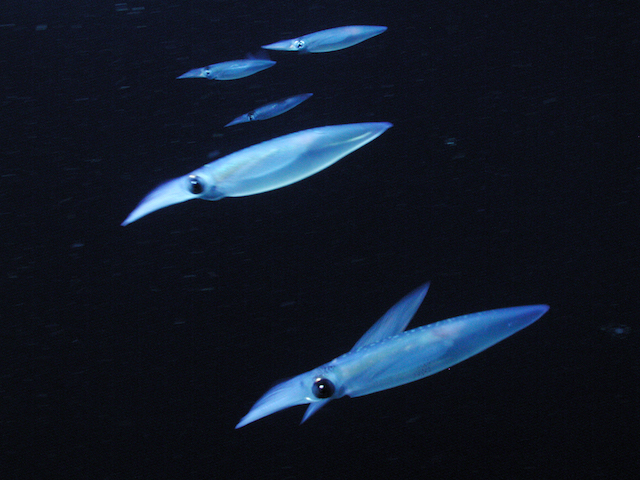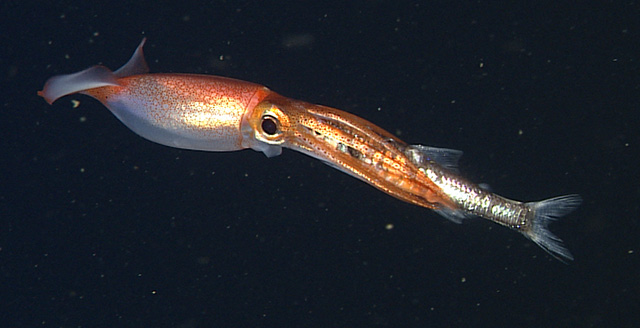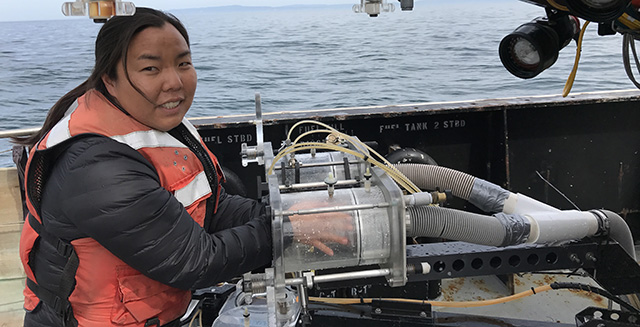Habitat
Midwater
surface (epipelagic) to twilight (mesopelagic) zone
Diet
Plankton
especially krill
Range
Worldwide
About
This little siphonophore has a big impact on deep-sea food webs.
Siphonophores (pronounced “sigh-fawn-oh-fours”) are delicate drifters made up of specialized segments that work together as one. These animals are like living commuter trains. Pulsing bells up front pull a long chain of segments specialized for feeding, defense, and reproduction.
Siphonophores are deadly beauties—they cast a net of tentacles to snare prey and are important predators in ocean ecosystems. In Monterey Bay, the common siphonophore (Nanomia bijuga) is one of the principal predators of krill. At times, this species can be quite abundant. Combined, the numerous Nanomia eat more krill than all the whales that gather to feast in the bay’s fertile waters.
This small siphonophore—only about 30 centimeters (12 inches) long—is a sit-and-wait predator. It casts stinging tentacles that are lined with knobby tips. Those bumpy bits resemble tiny shrimp-like creatures, making tasty bait for hungry plankton. But Nanomia is not a very patient predator. If nothing comes along in a few minutes, it retracts its tentacles and swims to another spot to try again.
Video Clips
Publications
Damian-Serrano, A., S.H.D. Haddock, and C.W. Dunn. 2021. The evolution of siphonophore tentilla for specialized prey capture in the open ocean. Proceedings of the National Academy of Sciences, 118: 1–9. https://doi.org/10.1073/pnas.2005063118
Robison, B.H., R.E. Sherlock, K.R. Reisenbichler, and P.R. McGill. 2020. Running the gauntlet: Assessing the threats to vertical migrators. Frontiers in Marine Science, 7: 1–10. https://doi.org/10.3389/fmars.2020.00064
Choy, C.A., S.H.D. Haddock, and B.H. Robison. 2017. Deep pelagic food web structure as revealed by in situ feeding observations. Proc Biol Sci, 284: 1–10. http://doi.org/10.1098/rspb.2017.2116
Burford, B.P., B.H. Robison, and R.E. Sherlock. 2014. Behaviour and mimicry in the juvenile and subadult life stages of the mesopelagic squid Chiroteuthis calyx. Journal of the Marine Biological Association of the United Kingdom, 95: 1221–1235. http://dx.doi.org/10.1017/S0025315414001763
Sherlock, R.E., and B.H. Robinson. 2000. Effects of Temperature on the Development and Survival of Nanomia bijuga (Hydrozoa, Siphonophora). Invertebrate Biology, 119: 379–385.
Silguero, J.M.B., and B.H. Robison. 2000. Seasonal abundance and vertical distribution of mesopelagic calycophoran siphonophores in Monterey Bay, CA. Journal of Plankton Research, 22: 1139–1153. http://dx.doi.org/10.1093/plankt/22.6.1139
Robison, B.H., K.R. Reisenbichler, R.E. Sherlock, J.M.B. Silguero, and F.P. Chavez. 1998. Seasonal abundance of the siphonophore, Nanomia bijuga, in Monterey Bay. Deep Sea Research Part II: Topical Studies in Oceanography, 45: 1741–1751. https://doi.org/10.1016/S0967-0645(98)80015-5


